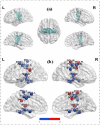Social Brain Network of Children with Autism Spectrum Disorder: Characterization of Functional Connectivity and Potential Association with Stereotyped Behavior
- PMID: 36831823
- PMCID: PMC9953760
- DOI: 10.3390/brainsci13020280
Social Brain Network of Children with Autism Spectrum Disorder: Characterization of Functional Connectivity and Potential Association with Stereotyped Behavior
Abstract
Objective: To identify patterns of social dysfunction in adolescents with autism spectrum disorder (ASD), study the potential linkage between social brain networks and stereotyped behavior, and further explore potential targets of non-invasive nerve stimulation to improve social disorders. Methods: Voxel-wise and ROI-wise analysis methods were adopted to explore abnormalities in the functional activity of social-related regions of the brain. Then, we analyzed the relationships between clinical variables and the statistical indicators of social-related brain regions. Results: Compared with the typically developing group, the functional connectivity strength of social-related brain regions with the precentral gyrus, postcentral gyrus, supplementary motor area, paracentral lobule, median cingulum, and paracingulum gyri was significantly weakened in the ASD group (all p < 0. 01). The functional connectivity was negatively correlated with communication, social interaction, communication + social interaction, and the total score of the ADOS scale (r = -0.38, -0.39, -0.40, and -0.3, respectively; all p < 0.01), with social awareness, social cognition, social communication, social motivation, autistic mannerisms, and the total score of the SRS scale (r = -0.32, -0.32, -0.40, -0.30, -0.28, and -0.27, respectively; all p < 0.01), and with the total score of SCQ (r = -0.27, p < 0.01). In addition, significant intergroup differences in clustering coefficients and betweenness centrality were seen across multiple brain regions in the ASD group. Conclusions: The functional connectivity between social-related brain regions and many other brain regions was significantly weakened compared to the typically developing group, and it was negatively correlated with social disorders. Social network dysfunction seems to be related to stereotyped behavior. Therefore, these social-related brain regions may be taken as potential stimulation targets of non-invasive nerve stimulation to improve social dysfunction in children with ASD in the future.
Keywords: autism spectrum disorder; brain functional network; functional connectivity; social-related brain regions; stereotyped behavior.
Conflict of interest statement
The authors declare no conflict of interest.
Figures




Similar articles
-
Dynamic functional connectivity analysis reveals decreased variability of the default-mode network in developing autistic brain.Autism Res. 2018 Nov;11(11):1479-1493. doi: 10.1002/aur.2020. Epub 2018 Oct 1. Autism Res. 2018. PMID: 30270547
-
Decreased interhemispheric functional connectivity rather than corpus callosum volume as a potential biomarker for autism spectrum disorder.Cortex. 2019 Oct;119:258-266. doi: 10.1016/j.cortex.2019.05.003. Epub 2019 May 15. Cortex. 2019. PMID: 31167156
-
Altered intrinsic brain activity and connectivity in unaffected parents of individuals with autism spectrum disorder: a resting-state fMRI study.Front Hum Neurosci. 2022 Sep 30;16:997150. doi: 10.3389/fnhum.2022.997150. eCollection 2022. Front Hum Neurosci. 2022. PMID: 36248683 Free PMC article.
-
[Social cognition in schizophrenia and autism spectrum disorder: Points of convergence and functional differences].Encephale. 2018 Dec;44(6):523-537. doi: 10.1016/j.encep.2018.03.004. Epub 2018 Aug 16. Encephale. 2018. PMID: 30122298 Review. French.
-
A Review of Default Mode Network Connectivity and Its Association With Social Cognition in Adolescents With Autism Spectrum Disorder and Early-Onset Psychosis.Front Psychiatry. 2020 Jun 25;11:614. doi: 10.3389/fpsyt.2020.00614. eCollection 2020. Front Psychiatry. 2020. PMID: 32670121 Free PMC article. Review.
Cited by
-
The Impact of Microglia on Neurodevelopment and Brain Function in Autism.Biomedicines. 2024 Jan 17;12(1):210. doi: 10.3390/biomedicines12010210. Biomedicines. 2024. PMID: 38255315 Free PMC article. Review.
-
Twinned neuroimaging analysis contributes to improving the classification of young people with autism spectrum disorder.Sci Rep. 2024 Aug 29;14(1):20120. doi: 10.1038/s41598-024-71174-z. Sci Rep. 2024. PMID: 39209988 Free PMC article.
-
Vasotocin receptor gene genotypes moderate the relationship between cortical thickness and sensory processing.Transl Psychiatry. 2023 Nov 21;13(1):356. doi: 10.1038/s41398-023-02657-2. Transl Psychiatry. 2023. PMID: 37990008 Free PMC article.
-
Event-Related Desynchronization of MEG Alpha-Band Oscillations during Simultaneous Presentation of Audio and Visual Stimuli in Children with Autism Spectrum Disorder.Brain Sci. 2023 Sep 13;13(9):1313. doi: 10.3390/brainsci13091313. Brain Sci. 2023. PMID: 37759914 Free PMC article.
References
-
- Maenner M.J., Shaw K.A., Baio J., Washington A., Patrick M., DiRienzo M., Christensen D.L., Wiggins L.D., Pettygrove S., Andrews J.G., et al. Prevalence of Autism Spectrum Disorder Among Children Aged 8 Years—Autism and Developmental Disabilities Monitoring Network, 11 Sites, United States, 2016. MMWR Surveill. Summ. 2020;69:1–12. doi: 10.15585/mmwr.ss6904a1. - DOI - PMC - PubMed
LinkOut - more resources
Full Text Sources

